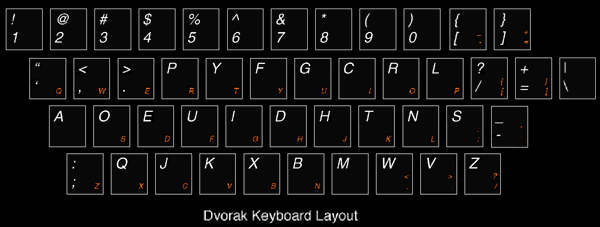Dvorak tools and info
Applets:
- Type
Dvorak on a Qwerty keyboard!
Use this to type on computers that don't have the Dvorak layout installed. This applet consists of a text box that converts keystrokes in Qwerty to the corresponding keystrokes in Dvorak.
- Dvorak
Typing Tutor
This is a great typing tutor (jTypist 3.1h) written as a java-applet. You can use it to learn to type Dvorak or Qwerty.

Images:
- dvlayout.gif (18k) A nice image of the layout
- dvlayout2.gif (5k) A black and white image of the layout
- dvlayout2_sm.gif (4k) A small version of above.
History:
The Qwerty keyboard layout (named so because of
the first 6 upper-left keys) is perhaps the most ancient aspect of today's
computers. The current arrangement of letters is actually designed to
slow one's typing, a holdover from the days of mechanical typewriters
whose keys would jam if pressed in quick succession. Rumor also has it
that the arrangement was partially designed to help typewriter salesmen
demo the machines by placing all of the letters in the word "typewriter"
in the top row (take a look for yourself).
The Dvorak (pronounced "duh-VOR-ack")
layout was scientifically developed in the 1920's to place to most
commonly used letters (in English) on the home row, to reduce the distance
that the average typist's fingers have to travel, and to more evenly distribute
the work load between left and right hands. The layout never took over
the typing world as some hoped. The reasons are many, but partially it
was due to the difficulty of physically changing existing typewriters
over and partially due to having to retrain existing touch-typists. It's
unknown today how many people use the Dvorak layout. The replacement of
the typewriter by the personal computer meant that one can change the
letters produced by one's keyboard easily and instantly.
Dvorak has been built into Windows since version
3.0, Apple's MacOS since version 8.5, and Unixes (ie. Linux, BSD, Solaris,
etc.) since forever. You can also switch DOS, older versions of MacOS,
and pretty much anything else to Dvorak. See the links below for instructions
on how.
Personal:
I taught myself to use Dvorak in early 1995
because of the onset of RSI. A friend
had been using it since he was a fetus and loved it. I found that after
practicing for a few days I could touch-type quite easily. Dvorak is
much easier to learn than Qwerty because the keys arranged sanely, vowels
under the left hand, common consonants under the right, instead of being
randomly arranged as in Qwerty. The only difficult aspect of learning
Dvorak was switching between Qwerty and Dvorak. It's very similar to
speaking two languages and having to switch back and forth between them.
I found it took a couple of months to be able to switch back and forth
without speed loss and a year or so to be able to do without thinking.
The pain in my wrists is gone these days. I attribute
this partly to better typing posture and partly to a better keyboard
layout. I've found that I can typing significantly faster using Dvorak
with much less effort (since my fingers spend much more time on the
home row). Additionally it keeps co-workers, roommates, and little brothers
from commandeering my computer, especially if there is a password (try
typing a password on a keyboard where the letters don't match the keys).
:)
Links:
- Find out how to install or switch to Dvorak on your machine
- All the Dvorak info you could ever want.
- A more do-it-yourself Dvorak typing course
- A well written
piece about the layout by the author of This
is True
Send comments or suggestions here